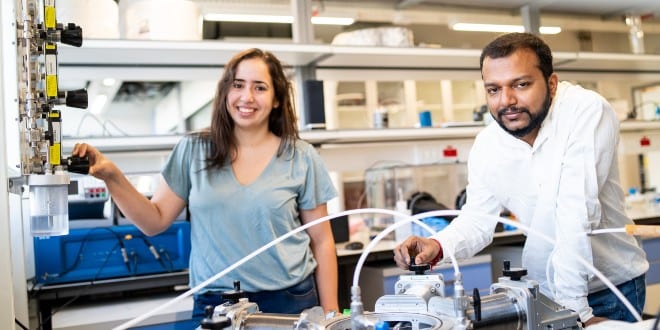A tremendous amount of packaging waste is thrown out by the food industry all around the world and in Israel as well. But they can – and should be recycled for reuse.
Scientists at the Technion-Israel Institute of Technology in Haifa have just published details in the journal Advanced Materials under the title “A Protein-Based Free-Standing Proton-Conducting Transparent Elastomer for Large-Scale Sensing Applications” about their success in creating conductors that can be used for solar energy generation, biomedical engineering and more using by-products of the food industry.
The technology they presented makes possible the simple, fast, cost-effective and environmentally friendly production of biopolymers, which include application for electrophysiological signal sensing.
Polymers are materials made of long, repeating chains of molecules an d have unique properties depending on the type of molecules being bonded and how they are bonded. Synthetic polymers include plastics, that use costly processes that cause pollution because they are made from derivatives of oil, gas and fossil fuel.
Biopolymers are natural polymers produced by the cells of living organisms. Among the natural ones are collagen, fibrin, starch, hair, fur, nails, cotton, gelatin, natural rubber, cellulose, wool and silk (created by silkworms).
Polypeptides such as collagen and silk are inexpensive biocompatible materials that are being used in groundbreaking research, as these are easily attainable materials. Gelatin polymer is often used on dressing wounds as an adhesive. Scaffolds and films with gelatin allow for the scaffolds to hold drugs and other nutrients that can be used to supply to a wound for healing.
Another widely used biopolymer is chitosan derived from the exoskeleton of crustaceans and insects, it can biodegrade which can eliminate a second surgery for implants, can form gels and films/ Ot cam also be used to improve drug absorption and stability and for gradual release of anti-cancer drugs.
In the food industry, biopolymers that are transparent. Biodegradable and water resistant are being used not only for packaging but also for edible encapsulation films and the coating of foods.
The Technion study was conducted in the Schulich Faculty of Chemistry under the leadership of Assistant Prof. Nadav Amdursky, head of the biopolymers and bioelectronics laboratory, and doctoral students Ramesh Nandi and Yuval Agam. “The current global green trend has not bypassed industry, and numerous groups worldwide are working on new solutions that will limit the pollution caused by the production of synthetic materials and by their very presence,” explained Amdursky. “One of the options is, of course, the use of natural materials, and the big challenge is to adapt them to meet needs.”
The two main approaches in environmentally conscious chemistry are environmental chemistry (the creation of environmentally friendly materials) and sustainable chemistry (production based on available degradable materials and energy-efficient processes). The new research integrates the two approaches in an environmentally friendly production process that yields environmentally friendly products in the context of conductive polymers.
The protein polymers used by the Technion researchers are by-products of the food industry that would otherwise be thrown into the garbage. “The inspiration to use proteins to create conductive polymers originated in the unique function of proteins in nature – they are exclusively responsible for transporting various charge carriers in flora and fauna; for example, in cellular respiration or in photosynthesis in plants,” he continued.
The researchers created transparent polymer films with high conductivity. This film is suitable for biological and biomedical applications since it is non-toxic and can be stretched to approximately 400% of its original length without significantly impairing its electrical properties. Its conductivity is among the highest detected in biological materials.
The team used bovine serum albumin (from cows), one of the most affordable proteins that results in the ability to create large-scale materials at a low cost. Due to the inherent biodegradability and biocompatibility of the elastomer, it is promising for biomedical applications, he said, and it can be used immediately as a solid-state interface for sensing electrophysiological signals,
“The production of the film in our research was a one-pot process, spontaneous, inexpensive, fast, energy efficient and nonpolluting,” said Amdursky. “In the article, we demonstrate the use of the film as ‘artificial skin’ that noninvasively monitors electrophysiological signals. These signals play a meaningful part in brain and muscle activity, and therefore their external monitoring is a highly important challenge.”
He stresses that since this technology is designed for application and commercialization, “the economic consideration is key, and consequently, it is most important to lower the costs of production processes so that they will yield a product that is competitive, also in terms of price, with petroleum-based polymers, and happily, we have succeeded. This is in addition to the reduction in environmental damage in the production phase as well as during use. The new polymer is fully biodegradable in less than 48 hours, as opposed to synthetic polymers, which are not biodegradable and as result, pollute our planet.”
The shortcode is missing a valid Donation Form ID attribute.




